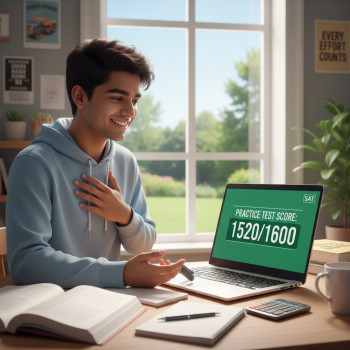Introduction: Why the SAT Still Matters for FLAME University Applicants
If you’re a student in India—or a parent guiding one—who dreams of studying at FLAME University, you’re probably juggling grades, essays, extracurriculars, and the ever-present question: do I need the SAT? The short, practical answer is: FLAME accepts international applications and treats standardized tests such as the SAT as a meaningful, recommended piece of evidence about academic readiness. While some admissions offices may weigh scores differently from year to year, showing a strong SAT performance can strengthen your application, especially if you want to highlight academic potential beyond your transcript.

Understanding FLAME’s Approach to Standardized Tests
FLAME University is internationally oriented and evaluates applicants holistically. That means the admissions team looks at multiple pieces of information—grades, recommendation letters, essays, portfolios (if relevant), extracurricular depth, and test scores. For many international applicants, the SAT acts as a common yardstick that admissions officers can use to compare academic readiness across different school systems.
Important to know: FLAME’s published profiles and international-facing college resources indicate that submission of SAT or ACT scores is recommended rather than strictly mandatory for all applicants. In practice this means:
- If your school system or grades are straightforward and your transcript is robust, you may still apply without an SAT, but having a strong SAT score can boost your candidacy.
- If your transcript is from a curriculum admissions officers may find difficult to interpret, a solid SAT score helps translate your potential into a familiar metric.
- If you are competing for merit-based aid or selective programs within FLAME, a strong SAT may provide a competitive edge.
Real-world context
Admissions offices at globally oriented universities often juggle applications from candidates who attend very different schools—some follow CBSE, others IB, IGCSE, state boards, or international curricula. The Digital SAT helps level that playing field by offering a single, standardized indicator. Think of it as an extra voice in your application—one that speaks in numbers but also signals readiness for college-level reading and math.
Digital SAT: What’s Different—and What You Should Expect
The SAT has moved fully digital. If you’re preparing now, here’s what matters most:
- The test is shorter in clock time but tightly focused; pacing matters more than ever.
- It’s adaptive in sections: the difficulty adjusts based on performance, which affects section-level strategy.
- There is an emphasis on evidence-based reading, problem solving, and mathematical fluency rather than obscure techniques.
- College Board offers official digital practice and tools—use them early and often to get comfortable with the interface and timing.
How the Digital SAT interacts with FLAME’s admissions
Because FLAME receives international applications, a Digital SAT score submitted through the College Board can be used in place of other standardized tests. Treat the Digital SAT as both a credential and a signal: a well-prepared score complements your academic record and essays, particularly for applicants from less-familiar schooling systems.
What Score Should You Aim For?
FLAME does not publish a rigid “cutoff” SAT score; rather, successful applicants typically present a combination of strong academic records and competitive test scores. Since FLAME’s profile data for SAT ranges may not always be available or fully representative—especially for international cohorts—your target should be personalized:
- For a competitive application: aim for a score above the global median for selective international programs (in practical terms, a competitive target would be in the upper percentiles for admitted students in similar liberal-arts or private institutions).
- For safety or bolstering a strong transcript: a solid, above-average score can still make a meaningful difference.
- Remember that a well-crafted application package (powerful essays, strong recommendations, demonstrated interest) multiplies the effect of your score.
Sample score-strategy table
| Application Goal | Digital SAT Target Range (Practical Guidance) | Why this helps |
|---|---|---|
| Highly Competitive (top programs or scholarships) | Top 10–15% of test takers | Signals academic readiness and helps in scholarship consideration |
| Strong applicant (solid grades, good ECs) | Above average—between 55th–85th percentile | Boosts profile; shows consistent aptitude |
| Complementary score (excellent transcript needs minor reinforcement) | At or slightly above average—40th–60th percentile | Reassures admissions about readiness without being the main focal point |
Note: Percentile targets are intended to be practical, not prescriptive. It’s better to set a realistic personal target based on your baseline mock-test performance, then improve steadily through a structured plan.
Timeline: When to Take the Digital SAT for FLAME Applications
Plan backward from FLAME’s application deadlines. A practical timeline looks like this:
- Junior year (or earlier): take a diagnostic Digital SAT to learn your starting point.
- 12–9 months before applications: build foundational skills and begin timed practice.
- 6–4 months before application deadlines: take a full official practice test under realistic conditions; identify weak areas.
- 3–2 months before deadlines: schedule your official Digital SAT so scores arrive before or around application submission dates. Keep a buffer for a potential retake.
Because official score reporting and processing can take a few weeks, avoid leaving your final test date too close to the application deadline.
How to Prepare: Smart, Not Just Hard
Studying for the Digital SAT is part strategy, part habit, and part targeted skills work. Here are steps that students (and parents) can follow:
- Baseline: take a full timed digital practice test to pinpoint strengths and weaknesses.
- Focus on fundamentals: reading comprehension tactics, algebraic fluency, data interpretation, and time-management techniques.
- Practice with the platform: the digital interface, on-screen tools, and adaptive format are different—familiarity reduces test anxiety.
- Quality over quantity: focused practice with review beats hours of untargeted questions.
- Simulate test conditions: practice full tests in one sitting, with realistic breaks and timing.
Example micro-plan for a busy student (12-week cycle)
- Weeks 1–2: Diagnostic test + targeted fundamentals (math review; reading strategies)
- Weeks 3–6: Focused drills (2–3 timed practice sections per week; error analysis)
- Weeks 7–9: Full practice tests every 10–14 days; refine pacing
- Weeks 10–12: Final targeted reviews; light practice; sleep and test logistics checklist
How Sparkl’s Personalized Tutoring Can Fit Naturally Into Your Prep
Preparing for a test that shapes part of your international application can feel overwhelming—this is where personalized support matters. Sparkl’s personalized tutoring is helpful because it provides 1-on-1 guidance that’s aligned with the Digital SAT format. A few natural benefits:
- Tailored study plans that match your diagnostic results and realistic schedule.
- Expert tutors who can break down tricky reading passages or math concepts into bite-sized strategies.
- AI-driven insights that highlight recurring errors and recommend targeted practice topics.
- Mental preparation and test-day strategies to manage timing and stress.
Used wisely, one-on-one tutoring reduces wasted practice time and helps students focus on the high-impact changes that raise scores efficiently.
Essays, Interviews, and the Whole Application Picture
While the SAT is an important component, FLAME’s holistic review means essays, recommendations, and demonstrated interest matter too. Here’s how to think about the balance:
- Essay: Use it to reveal personality, intellectual curiosity, and fit with FLAME’s learning culture.
- Recommendations: Choose teachers who can speak to your academic curiosity and growth.
- Extracurriculars: Depth and leadership trump a long list of surface-level activities.
- Portfolios or additional submissions: If you’re applying for creative or specialized programs, include samples that display your best work.
A strong SAT score complements these elements by confirming academic readiness, but it rarely replaces a thoughtful essay or a compelling portfolio.
How to create application synergy
Think of your application as a story. The SAT provides factual evidence—your essays and recommendations tell the story behind that evidence. When they align, the admissions reader gets a cohesive picture: strong academic preparation (SAT) + intellectual curiosity (essays) + demonstrated impact (ECs).
Practical Tips for Test Day and Score Submission
- Test day: sleep well, have a healthy breakfast, and arrive early. For digital testing, double-check any device and ID requirements, and understand the check-in procedures.
- Score choice: decide whether to send your best score or all scores based on FLAME’s stated policy. When in doubt, sending your best official Digital SAT score is typically wise.
- Reporting timeline: submit scores in plenty of time so admissions officers have them when reading your file. Allow a few weeks for processing.
Common Questions from Students and Parents
Q: Is the SAT mandatory for FLAME?
A: The SAT is generally recommended for international applicants. It’s best to check the specific application cycle and program requirements on FLAME’s admissions page, but as a rule, a strong SAT score strengthens an application—especially when admissions officers are comparing students from different schooling systems.
Q: Should I prioritize the SAT over my school exams?
A: No. School grades and the quality of your academic record remain the most important long-term indicators of your ability to succeed in college. Treat the SAT as an amplifier: it can highlight and validate the academic strengths already visible in your transcript.
Q: What if I can’t travel to a test center?
A: The Digital SAT rollout includes broader access at approved test centers. If travel is a barrier, plan early to find a suitable center and date; also investigate testing windows and international center availability. If constraints persist, speak with FLAME admissions about alternative documentation that can convey academic readiness.
Checklist: Preparing Your SAT Strategy for FLAME
- Take a diagnostic Digital SAT to set a baseline.
- Create a realistic 3–6 month study calendar with timed practice tests.
- Use platform-specific practice to get comfortable with the digital interface.
- Consider 1-on-1 tutoring if you need targeted improvements—Sparkl’s personalized approach can save time and boost gains.
- Schedule your test with a buffer for a possible retake.
- Coordinate score submission so FLAME receives your results before the admissions review.
- Balance SAT prep with essays, recommendations, and other application components.

Final Thoughts: Make the SAT Work for Your Story
Applying to FLAME University is about more than one test. It’s about presenting a thoughtful, well-rounded profile that reflects who you are intellectually and personally. The Digital SAT is a tool—one that can make your academic readiness clearer to admissions committees across the globe. Prepare strategically, keep your study plan balanced with other application priorities, and don’t be afraid to seek targeted help. Personalized tutoring—like Sparkl’s 1-on-1 guidance and AI-driven insights—can be a sensible investment when you need to accelerate improvement without burning out.
Above all, remember: admissions readers want to see your best, most authentic self. Use the SAT to reinforce the narrative you’ve created with your grades, essays, activities, and recommendations. When those pieces fit together, you give FLAME a compelling reason to say yes.
Resources & Next Steps
Start with a diagnostic test. Build a plan based on your baseline. If you find certain skills lagging, consider targeted tutoring—especially options that provide personalized study plans and actionable feedback. Reserve time to polish your essays and gather strong recommendations so your application to FLAME tells a consistent, memorable story.
Parting encouragement
College applications are a marathon, not a sprint. The Digital SAT is one segment of the race—prepare for it deliberately, rest strategically, and keep your long-term goals in view. With steady work and the right support, you’ll put forward an application that truly reflects your potential.
















No Comments
Leave a comment Cancel